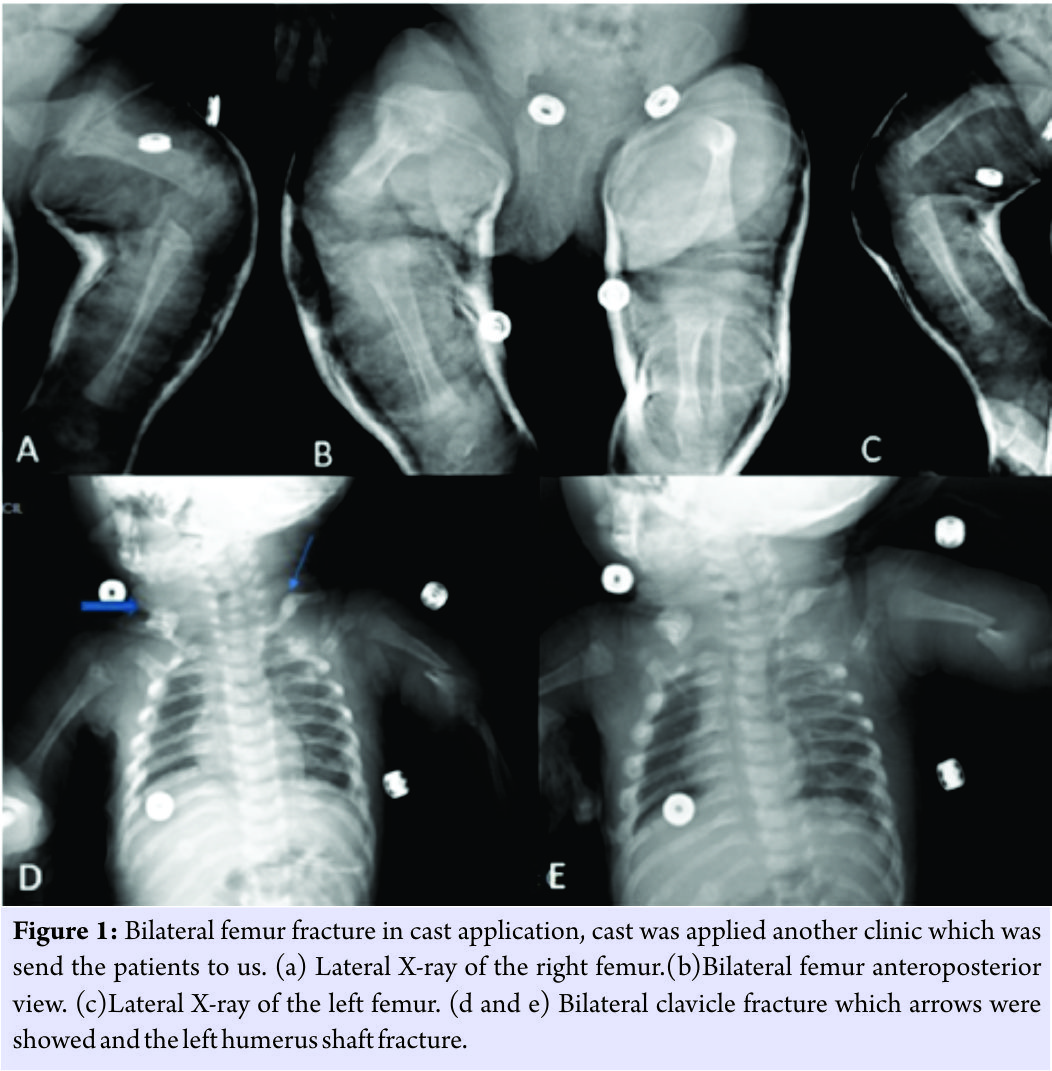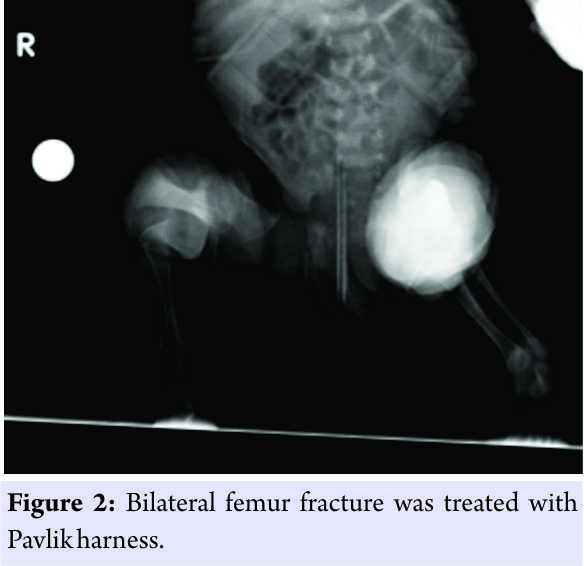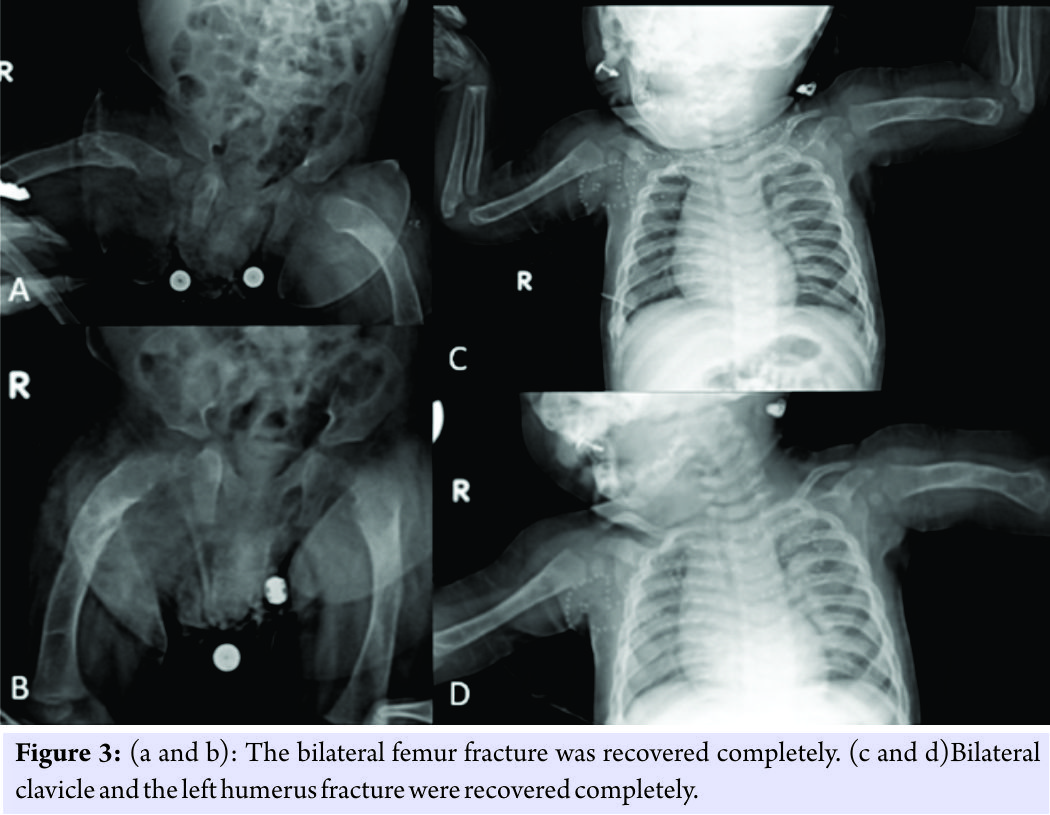[box type=”bio”] Learning Point for the Article: [/box]
Multiple bone fractures in the newborn can be associated with trauma as well as metabolic bone disease or hereditary bone dysplasia.
Case Report | Volume 8 | Issue 3 | JOCR May – June 2018 | Page 71-73| Serkan Bayram, Lezgin Mert, Fikret Berkan Anarat, Mechmed Chodza, Ömer Naci Ergin. DOI: 10.13107/jocr.2250-0685.1116
Authors: Serkan Bayram[1], Lezgin Mert[1], Fikret Berkan Anarat[1], Mechmed Chodza[1], Ömer Naci Ergin[1]
[1]Department of Orthopedic and Traumatology, Istanbul University, Istanbul Faculty of Medicine, Istanbul, Turkey.
Address of Correspondence:
Dr. Serkan Bayram,
Department of Orthopedic and Traumatology Istanbul University, Istanbul Faculty of Medicine, Millet cad, Vatan bulvari, Fatih, Çapa, Istanbul – 34100, Turkey.
E-mail: dr.serkanbayram89@gmail.com
Abstract
Introduction: Multiple bone fractures in a newborn can be associated with osteogenesis imperfect (OI). OI is a rare genetic disorder that causes Type I collagen synthesis disturbance results in bone fragility.
Case Report: We present a female newborn which had numerous fractures of the humerus, bilateral clavicle, and bilateral femur. Her delivery was at 36 weeks gestation by spontaneous vaginal delivery. She had has not any pathological symptom at 2 weeks after birth, the patient had a fracture of the humerus, bilateral clavicle, and femur without any trauma. Genetic analysis of the patient was reported and OI diagnosed. The patient was followed up for 8 months with regularly and without any complication.
Conclusion: Multiple fractures with OI in an infant after birth may require an accurate orthopedic plan for diagnosing and treatment.
Keywords: Newborn, multiple fracture, osteogenesis imperfect.
Introduction
Multiple bone fractures in the newborn can be associated with trauma as well as metabolic bone disease or hereditary bone dysplasia [1]. Identification of the underlying disease correctly is crucial for multiple fracture treatment and care. Therefore, radiological, laboratory, and clinical evaluations, including genetic studies, must be done properly. Osteogenesis imperfecta (OI) is the most common cause of multiple fractures in newborns. OI, which is the most common cause of genetic osteoporosis, is seen in approximately 1/20,000 ratio [2]. In this case, we aimed at a newborn patient with bilateral clavicle, bilateral femur, and left humerus fracture with OI without any history of trauma.
Case Report
The prob and was the first child of healthy, 18-year-old mother. Parents were Syrian refugee. No relevant history was found. She was delivered at 36 gestation week by spontaneous vaginal delivery caused by premature rupture of membrane. She was 18 years old and G1P1. The delivery and pregnancy were uneventful. When examined the baby was active and pink. The baby weighed 2870g. She was not dyspneic. The chest was clear with normal heart sound. The abdomen was soft with no enlarged organs. The cord was tied without any problems. The baby was conscious with normotensive. Her parents did not describe any trauma. During the 2nd week of life, the baby became distressed whenever she was handled and bilateral arm and legs movements decreased spontaneously. She was admitted to a hospital. She was in good general condition, but she screamed in pain when bilateral legs and the left arm were moved, and bilateral clavicle was in pain with palpation in her examination. Blood tests revealed normal morphology and count of blood cells, and the C-reactive protein was negative. Laboratory values for Ca, P, and parathyroid hormone (PTH) were normal (PTH was 12, CA: 8.9, P: 3.7).25-hydroxyvitamin D level was 5ng/mL, between the normal range. X-ray examination was revealed the fractures: Bilateral clavicle, bilateral femur shaft, and left humerus shaft (Fig. 1). 

Discussion
There are several genetic disorders and congenital defect conditions that have been associated with bone fragility and fractures that can be misdiagnosed as child abuse [3]:OI, osteopenia or rickets of prematurity, infantile myofibromatosis, Cole-Carpenter syndrome, and lethal gracile bone dysplasias (LGBDs). OI is the most common genetic abnormality associated with multiple unexplained fractures in an infant or child that can be misdiagnosed as child abuse [4]. Generalized osteoporosis with underossified skull and spine, anisospondyly, multiple long bone, and rib fractures makes the diagnosis of OI usually easy. Of the osteogenesis subtypes, Type IIA is especially characterized by multiple fractures in rib fractures and also multiple fractures [5]. Due to these subtypes have diffuse hypomineralization in the bones, they can be diagnosed by prenatal ultrasonography [6]. In this subtype, respiratory problems are very common, and the patients are usually lost in the perinatal period. Preterm rickets was also with multiple unexplained fractures in an infant [7]. Infants were
examined for clinical signs of rickets. There were also X-rays of any site of body taken for clinically suspected fractures. However, it is known that a large number of genetic disease groups are involved in the newborn multiple fractures. Disease groups such as LGBD, which have significant facial
dysmorphism, short extremity, and short hand-foot characteristics, can also cause multiple fractures [8]. Femur fracture can be treated with Pavlik harness successfully [9]. Advantages of the Pavlik harness in the treatment of femur fractures include ease of application, minimal cost, reduced hospitalization, and ease of nursing care and diapering for infant. For this reason, the use of the Pavlik harness is recommended by the American Academy of Orthopaedic Surgeons for patients younger than 6 months of age.
Conclusion
Multiple fractures following delivery should be looked out for genetic disease groups which are involved in the newborn multiple fractures such as OI, especially in babies with decreased extremity movements. Thorough clinical examination and proper orthopedic consult in the event of doubtful presentation would help. These fractures have very good prognosis and show complete healing following appropriate immobilization.
Clinical Message
Multiple bone fractures in the newborn can be associated with trauma as well as metabolic bone Disease or hereditary bone dysplasia. Thorough clinical examination and proper orthopedic consult in the event of doubtful presentation would help.
References
1. Jenny C. The committee on child abuse and neglect. Evaluating infants and young children with multiple fractures. Pediatrics 2006;118:1299-303.
2. Bastos F, Perez LT, Narváes CPL, Costa O, Souto da Silva RC, Van-Dunem JC, et al. Severe osteogenesis imperfecta: Case report. Einstein 2010;8:480-2.
3. Wardinsky TD. Genetic and congenital defect conditions that mimic child abuse. J Fam Pract 1995;41:377-83.
4. Kocher MS, Dichtel L. Osteogenesis imperfecta misdiagnosed as child abuse. J Pediatr Orthop B 2011;20:440-3.
5. Rauch F, Glorieux FH. Osteogenesis imperfecta. Lancet 2004;363:1377-85.
6. Ruano R, Molho M, Roume J, Ville Y. Prenatal diagnosis of fetal skeletal dysplasias by combining two-dimensional and three dimensional ultrasound and intrauterine three-dimensional helical computer tomography. Ultrasound Obstet Gynecol 2004;24:134-40.
7. Koo WW, Sherman R, Succop P, Krug-Wispe S, Tsang RC, Steichen JJ, et al. Fractures and rickets in very low birth weight infants: Conservative management and outcome. J Pediatr Orthop 1989;9:326-30.
8. Kozlowski K, Masel J, Sillence DO, Arbuckle S, Juttnerova V. Gracile bone dysplasias. Pediatr Radiol 2002;32:629-34.
9. Rush JK, Kelly DM, Sawyer JR, Beaty JH, Warner WC Jr. Treatment of pediatric femur fractures with the pavlik harness: Multiyear clinical and radiographic outcomes. J Pediatr Orthop 2013;33:614-7.
 |
 |
 |
 |
 |
| Dr. Serkan Bayram | Dr. Lezgin Mert | Dr. Fikret Berkan Anarat | Dr. Mechmed Chodza | Dr. Ömer Naci Ergin |
| How to Cite This Article: Bayram S, Mert L, Anarat F B, Chodza M, Ergin Ö N. A Newborn with Multiple Fractures in Osteogenesis Imperfecta: A Case Report. Journal of Orthopaedic Case Reports 2018. May- June; 8(3): 71-73. |
[Full Text HTML] [Full Text PDF] [XML]
[rate_this_page]
Dear Reader, We are very excited about New Features in JOCR. Please do let us know what you think by Clicking on the Sliding “Feedback Form” button on the <<< left of the page or sending a mail to us at editor.jocr@gmail.com





